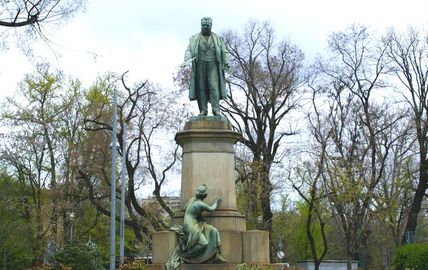

The Cavour Square, which is dominated by the enormous white Palace of Information, a remnant of the Fascist Era, is dedicated to one of the three most important figures of Italian Unification, Italy's first Prime Minister, Camillo Benso, Count of Cavour.
Camillo Cavour was born in Turin in 1810 while the embattled Kingdom of Savoy was briefly part of the French Empire. Of aristocratic descent, he embraced a more progressive view of society after finishing the military academy and travelling through Northern Europe, where he observed government debates and spoke with various liberally oriented politicians. He entered politics in 1832 by becoming mayor of Grinzane, the town near Turin where the family estate was located, and remained in that position until 1848 when the revolutionary uprisings were sweeping across Europe.
He developed a strong belief in free trade and economic progress in general, without which it would be impossible to build the democratic institutions of freedom of opinion, division of powers and secular rule. He enthusiastically promoted the construction of railroads, canals and steamboats. He was an eloquent and convincing speaker when elected to Parliament, successfully covering the posts of Minister of Agriculture, of Commerce, of Navy and of Finance for the Savoy Kingdom in the early 1850s. In 1852, under King Vittorio Emanuele, Cavour became Prime Minister of Savoy.
Cavour is usually considered the architect and mastermind of Italian Unification. He developed the strategy that sought to form the single country out of a fragmented political landscape. Regions such as Tuscany and Emilia Romagna entered the union on their own, while other territories, such the Kingdom of Two Sicilies - consisting of Sicily and today's Campania, Puglia and Basilicata - had to be conquered. For this Cavour turned to the finest general of the day, Giuseppe Garibaldi, who led the military campaigns in the south and defeated the Bourbon army. Cavour, Garibaldi and King Vittorio Emanuele became the great triumvirate of the new Kingdom of Italy that was established in 1861, with Cavour as its first Prime Minister. Unfortunately, just three months into his mandate, Cavour suddenly fell ill and died - his death being attributed to malaria. Although Cavour is usually credited with having said, "We have made Italy; now we must make Italians," those words actually belong to Piedmont statesman, Massimo d'Azeglio, who had been Prime Minister of the Savoy Kingdom before Cavour.
Today historians are still debating whether Cavour really wanted a unified Italy or he was just working to expand the Kingdom of Savoy. Essentially, the two became one and the same, and because the south remained heavily underdeveloped until the arrival of Mussolini in the 1920s, it is not entirely incorrect to assume that the southern Kingdom of Two Sicilies had just been an annexation for the House of Savoy and not really one territory uniting with another territory on equal terms.
The bronze monument of Camillo Cavour standing on a granite pedestal in the middle of the square is a work by Odoardo Tabacchi. It was created in 1865 and depicts the statesman as he presides over parliament with the document of unification in his right hand. At the foot of the pedestal is a half-naked female figure embodying the new Kingdom of Italy, sculpted by Antonio Tantardini.